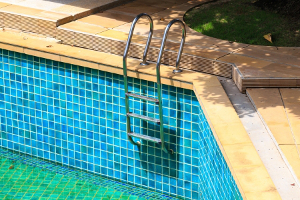 You may be considering removing your aging inground pool. You can probably think of several good reasons for removing it. Aging pools are liability hazards that are expensive to repair and maintain. In time, the pool is not worth the headaches it causes. It takes up yard space that you would like to reclaim.
You may be considering removing your aging inground pool. You can probably think of several good reasons for removing it. Aging pools are liability hazards that are expensive to repair and maintain. In time, the pool is not worth the headaches it causes. It takes up yard space that you would like to reclaim.
If you are getting ready to sell your house, your pool will turn off many potential buyers. Perhaps it is time for you to look into removing your old pool. If so, consult with a qualified pool removal service contractor to talk about removing your pool. An experienced contractor can evaluate your site, access to your pool, and any special issues associated with your removal project.
The Different Types Of Pool Removal Services
When it comes to removing a pool, you have two choices: partial removal and full removal. Before you commit to either one, make sure you understand the advantages and disadvantages of each one. A reputable contractor will be willing to discuss everything with you to help you make this important decision.
Partial Pool Removal
The Overview
At the surface, the contractor will cover it with soil if you want to reclaim it as yard space. Alternatively, your plans may include yard space with a new patio. Your contractor can probably help you with that as well. When the job is finished, you should not know that a pool was once there. Depending on the size of the pool and the difficulty of access by heavy demolition equipment, the entire process can be completed in two to five days.
The Process
With partial removal, your contractor will obtain the necessary permits for demolition and plumbing and electrical disconnects. Once permits are in place and the plumbing is disconnected, the contractor will drain the pool of any water. The next step is to drill holes in the bottom of the pool to ensure that any moisture that collects will drain off. Once the pool bottom is properly broken up, the contactor will demolish the top 18 inches of the pool wall and remove any unwanted decking. The debris will be placed into the remaining pool shell. It will then be backfilled with gravel and dirt, then compacted to prevent the surface from sinking over time.
The Cost
 You should expect to pay at least $5,000, and potentially more if the pool is large and site access is difficult. Whether partial removal is a viable option for you depends on the applicable laws and covenants that apply and your plans for future use of the property. Use an experienced and reputable pool removal service contractor to ensure that you comply with applicable laws concerning partial removal.
You should expect to pay at least $5,000, and potentially more if the pool is large and site access is difficult. Whether partial removal is a viable option for you depends on the applicable laws and covenants that apply and your plans for future use of the property. Use an experienced and reputable pool removal service contractor to ensure that you comply with applicable laws concerning partial removal.
The Benefits
Partial removal is less expensive than full removal and is the most common method of removal. It is sometimes described as simply filling in a pool as it also takes considerably less time. Instead of waiting several more weeks for the concrete aggregate to be fully removed and hauled off, it becomes part of the base and simply gets covered with the remaining fill dirt. You can enjoy your backyard quicker than you would have been able to with a full removal.
The Drawbacks
Though partial removal is about half the cost of full removal, partial removal has a few disadvantages. When you sell the house, you will likely have to disclose the existence of the debris-filled pool. Also, with partial removal, you could experience some settling and sinking of the surface over time. The pool debris left in the ground can settle and create irregular spaces that cause unexpected sinking at the surface. For this reason, most building codes prohibit building a new structure on the site of a partially filled pool. If you plan to build a new structure on or near the site, you will have to fully remove the pool.
Full Pool Removal
The Overview
As noted earlier, full removal is more expensive than partial removal. Nonetheless, full removal is normally the best option. Full removal means that the entire pool is demolished and removed by the pool removal service company. Once the full pool removal service is completed, nothing of the pool will be left in the ground. Sodding and any hardscape material can now be installed on the surface. Your contractor may provide that service or you may need a landscape contractor to beautify the site.
The Process
Once appropriate permitting is in place and utilities disconnected, the pool is ready to remove. The contractor first will first drain any water from the pool. Once drained, the contractor will demolish the pool shell to break it up into pieces. Those materials usually include concrete, vinyl, tile, steel, and fiberglass. Your contractor will use special equipment to completely remove the pieces and haul it all away. In many cases, materials such as concrete and steel can be responsibly recycled. Next, the contractor will backfill the now empty cavity with gravel and soil. The surface will be compacted.
The Cost
Expect to pay at least $10,000 for complete removal of an average small or medium-sized pool with easy access to the site. Full removal takes more time to complete than partial removal, requires more material to fill the cavity, and may require specialized equipment to remove all of the debris.
The Benefits
 Full pool removal has advantages over partial removal. Once the pool is fully removed, the space can be used without restriction. It is safe enough to build a new structure on it. The ground will have fewer issues with sinking because the compacting process will be simpler. No buried chunks of debris will remain to create underground cavities.
Full pool removal has advantages over partial removal. Once the pool is fully removed, the space can be used without restriction. It is safe enough to build a new structure on it. The ground will have fewer issues with sinking because the compacting process will be simpler. No buried chunks of debris will remain to create underground cavities.
The Drawbacks
The const of a full inground pool removal can sometimes be more than double that of a partial removal. While you will be able to build anything you want over the brand-new space, the removal will take significantly longer to complete. Should you choose a full removal, your contractor will have to haul the concrete that was once the frame of the pool to a material drop-off location, which may take a considerable chunk of time.
Which One Is Best For My Backyard?
Oftentimes, it is recommended that homeowners choose a full pool removal. However, we understand that everyone’s living and financial situations are different. By now, you have probably realized that pool removal requires more than a friend with a bulldozer. It is crucial to discuss your unique needs and situation with a demolition expert who is properly equipped for pool demolition and removal.
Find a contractor who is experienced with the permitting required by your locality and is willing to consult with you about the best option for your budget and your goals. A highly trained and professional removal service can make the entire process easier for you. Additionally, they will help you determine which method of pool removal is best for your family and your backyard.
Speak With Our Specialized Pool Removal Contractors
If you are considering inground pool removal, reach out to our team of experts. The reputable pool removal contractors Dirt Connections can handle permits, demolition, filling, grading, landscape clean-up and any other task involved with the pool removal service smoothly, efficiently, and safely. Contact us online to get started and receive an estimate on your pool removal as soon as today.








































